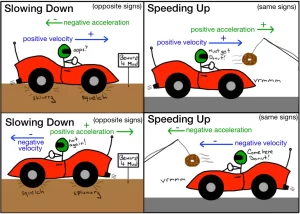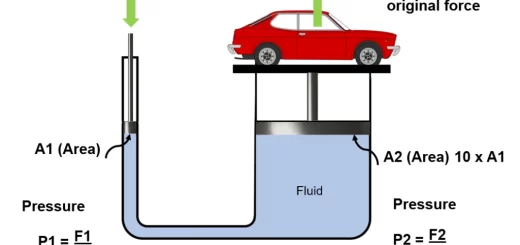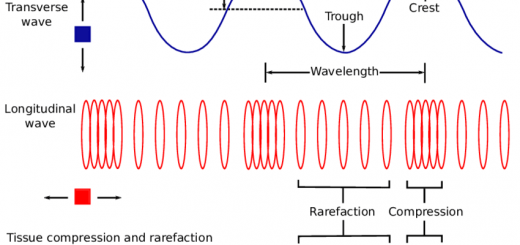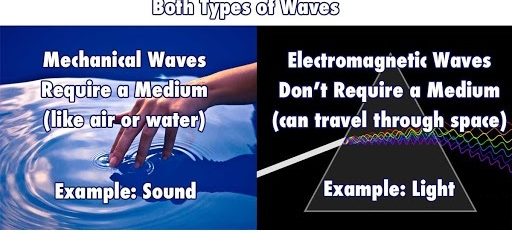Types of Acceleration, Uniform Acceleration and Non-uniform Acceleration
Uniform acceleration and non-uniform acceleration are two ways to describe how the velocity (speed and direction) of an object changes over time. If the velocity of an object is changed from one point to another either in magnitude or direction, This change in velocity with time is known as acceleration, and such motion is called accelerated motion.
Acceleration
Acceleration is the change of the object’s velocity per unit of time or it is the rate of change of velocity, Accelerated motion is the motion in which velocity changes with time, Acceleration of motion can be found by the relation:
Acceleration = Change in velocity / Time of change
Acceleration = ( Final velocity − Initial velocity ) / ( Final time − Initial time )
a = Δ v / Δ t = ( v2 − v1 ) / ( t2 − t1 )
The unit of measuring acceleration is m/s² or km / h² and its dimensions LT−2, You can convert the unit of measuring acceleration from km / h² into m / s² as follows :
1 km / h² = 1 km / ( 1 h )² = 1000 m / [ (60 × 60) s² ] = 5 / ( 18 )² m / s²
Uniform Acceleration refers to motion in which the velocity of an object changes at a constant rate over time, So, the object’s acceleration remains the same throughout its motion. Examples of uniform acceleration include:
An object in free fall near the Earth’s surface (ignoring air resistance) accelerates uniformly due to gravity at approximately 9.8 m/s29.8m/s2. A car increasing its speed by 5 m/s every second on a straight road is also under uniform acceleration.
In mathematical terms, if an object has an initial velocity u, a uniform acceleration a, and time t has passed, its final velocity v can be calculated as:
v = u + at
Non-uniform acceleration takes place when the rate of change of velocity is not constant, so, the object’s acceleration varies over time, This type of acceleration might increase, decrease, or fluctuate in an irregular pattern. Examples include:
A car moving through traffic, where it slows down, speeds up, and stops intermittently. A roller coaster moving along a track with varying inclines and declines.
Since the acceleration isn’t constant in non-uniform acceleration, calculating the velocity and position requires using calculus, integrating acceleration as a function of time.
Types of Acceleration
Uniform Acceleration
Uniform Acceleration is the acceleration in which the object changes its velocity with equal intervals of time. Uniform Acceleration is also called constant acceleration. An object has uniform acceleration if its velocity changes by the same amount in equal intervals of time.
Imagine a car speeding up on a straight road. If the car gains the same amount of speed every second, it’s undergoing uniform acceleration. The free fall of an object near the Earth’s surface (ignoring air resistance) is a good example of uniform acceleration due to gravity.
Non-uniform Acceleration
It is the acceleration in which the object changes its velocity with unequal intervals of time, The acceleration may be positive acceleration (increasing velocity), Zero acceleration (uniform velocity), or Negative acceleration and in this case, it is called deceleration (decreasing velocity).
When the velocity of an object increases with time, This is called positive acceleration, when the velocity of the object is constant with time, This is called zero acceleration, when the velocity of object decreases with time, This is called negative acceleration. An object has non-uniform acceleration if its velocity changes by different amounts in equal intervals of time.
Positive acceleration
It is the object’s acceleration when its velocity increases with time, Example: As the ball rolls down the inclined plane.
Zero acceleration
It is the acceleration when the velocity of the object is constant with time, Example: as the ball moves along the smooth horizontal plane.
Negative acceleration
It is the object’s acceleration when its velocity decreases with time, Example: As the ball climbs up the inclined plane.
Uniform and non-uniform acceleration examples
Uniform acceleration is found in scenarios with constant forces (like free fall with gravity). Non-uniform acceleration occurs in more dynamic, variable environments (like traffic or varying terrain).
Examples of Uniform Acceleration
- Free Falling Objects: An object dropped from a certain height (ignoring air resistance) accelerates towards the Earth at a constant rate of approximately 9.8 m/s29.8m/s2 due to gravity.
- A Car on a Straight Road with Constant Acceleration: If a car accelerates from a standstill to a certain speed with a constant increase in velocity, such as increasing its speed by 5 m/s every second, it is undergoing uniform acceleration.
- Motion of a Trolley Down an Inclined Plane (Without Friction): When friction is negligible, a trolley rolling down a slope experiences a constant acceleration due to gravity.
- Rocket Launch (in ideal conditions): During the initial phase of a launch in a vacuum, if the thrust produces constant acceleration, the rocket moves with uniform acceleration.
Examples of Non-Uniform Acceleration
- A Car in Traffic: In real-world driving, a car’s speed varies as it accelerates and decelerates due to traffic signals, other vehicles, or road conditions. This results in non-uniform acceleration.
- Cycling on a Hilly Terrain: As a cyclist pedals up and down hills, the acceleration changes frequently, depending on the slope and the cyclist’s effort, making it non-uniform.
- A Roller Coaster Ride: A roller coaster experiences changing speeds and directions at different points along its track, leading to varying accelerations throughout the ride.
- A Pendulum Swing: The acceleration of a swinging pendulum is non-uniform, as it changes direction and magnitude throughout its motion.
Graphical representation
When plotting the graphical relationship of ( velocity – time ) we may get:
A straight line that may start from the origin, By finding the slope of the straight line, we obtain the acceleration of the object’s motion, when the slope of the line is positive, It is a positive acceleration, The object is moving at a uniform acceleration.
A straight line parallel to the time axis, It is zero acceleration, The slope of the line = 0, and The object is moving at zero acceleration.
A straight line that may end at the time axis, The slope of the line is negative, It is negative acceleration, The object is moving at a uniform deceleration.
The projectile whose velocity decreases till it reaches zero at its maximum height represents an example of negative acceleration.
When the object moves at a uniform acceleration = 10 m/s², It means that the object’s velocity increases by 10 m/s every second.
When an object decelerates uniformly at − 10 m/s², It means that the object’s velocity decreases by 10 m/s every second.
Guidelines to solve problems
To solve the problems of acceleration, use the diagram:
- Where Δ v is the change in velocity which is determined by the relation: Δ v = vf − vi.
- If the object moves at uniform velocity, its acceleration of motion = zero because Δ v = zero.
- When the object starts motion from rest, its initial velocity (vi) = zero.
- When the object comes to rest, its final velocity (vf) = zero.
- When the final velocity (vf) > the initial velocity (vi), acceleration is positive.
- When the final velocity (vf) < the initial velocity (vi), acceleration is negative.
- When the final velocity (vf) = the initial velocity (vi), the acceleration is zero (uniform velocity).
- If the velocity and acceleration have the same direction then they have the same sign (Acceleration motion).
- If the velocity and acceleration have opposite directions then they have the opposite signs (Decelerating motion).
The meaning of the (− ve) sign for:
- Displacement: The body moves in the opposite direction.
- Velocity: The body moves in the opposite direction.
- Δ v (change in velocity): The velocity of the body decreases.
- Acceleration: The velocity decreases or acceleration is in the opposite direction to velocity.
Time is never written with a negative value as it is a scalar quantity.
Acceleration types, units, importance and Graphic representation of moving in a straight line
Safety skills, Applications of motion with uniform acceleration (Free fall and Projectiles)





Thanks
You are welcome